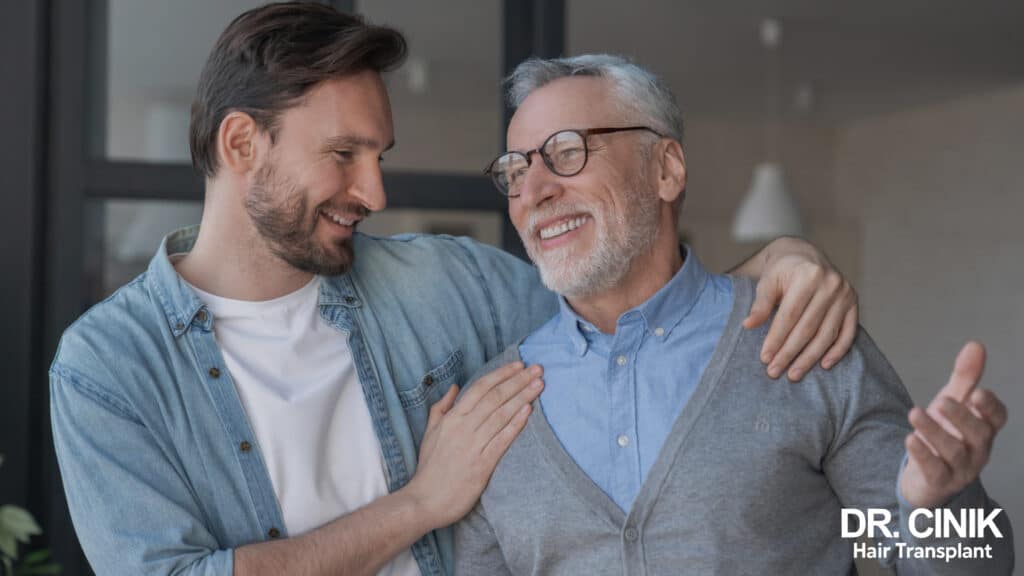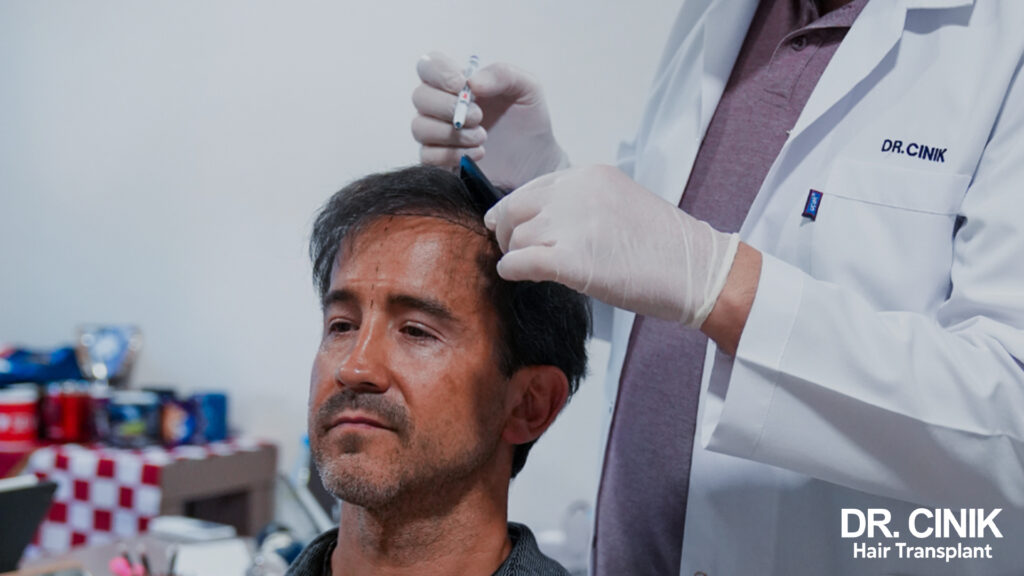Hair and Beard Implant

Sommaire
Beard and hair are two main contributors to self-confidence. You can get your desired style with a hair or beard implant.
Natural Hair, Your Best Accessory
Having a natural and attractive hairstyle is a key factor of total charm and attraction. Hairstyle is one of the most recognizable elements of appearance, so everyone spends a lot of time, money, and effort trying to keep it elegant.
Unfortunately, this important factor of our attraction can easily be damaged and even fall out entirely. Hair loss is a common problem among men and women, and every day, thousands of new members join the society of “people who want their hair back”. (1)

Causes of Hair Loss
Generally, the main cause of the weakness of hair follicles has been a mystery for scientists, but they have put their fingers on several situations and causes of hair loss (2). Among the most common causes of hair loss are:
- Genetics: A man or a woman can inherit abnormal genes, causing pattern baldness from their parents, male or female.
- Stressful Lifestyle: Some temporary hair losses can occur due to a stressful lifestyle as stress can affect the entire system of the body.
- Hormones: Unusual levels of several hormones cause permanent hair loss.
- Drugs: Mainly causing temporary hair losses, some drugs, namely chemotherapy drugs and blood thinners, are other culprits of hair loss.
- Injuries: Harms on the skin can damage hair follicles and cause temporary or permanent hair loss.
- Sicknesses: A group of diseases and medical conditions like Thyroid and diabetes can cause temporary hair loss.
- Poor Diet: Poor diet habits like ignoring healthy food which provides protein and vitamins can cause hair loss.
- Chemicals: Using shampoos and hair products that carry chemical substances like sulfates can harm hair follicles and cause hair loss.
- Autoimmune Disease: The main reason for alopecia areata, these types of diseases can cause permanent hair loss as the immune system attacks hair follicles.
Psychological Effects of Hair Loss
It can easily be claimed that the psychological side of hair loss is the biggest pain you deal with while experiencing hair loss. Some of the psychological effects (3) of hair loss are:
- Social Phobia
- Anxiety
- Depression
- Self-Confidence deterioration
It should be noted that as stress is a common cause of hair loss, the psychological effects of hair loss can exacerbate the situation and increase the hair fall rate.
The situation gets worse if you attempt to overcome these psychological disorders by using medications. Most medications for depression and psychological complications cause hair loss.
Hair Loss Treatments
As hair loss is a common problem, lots of remedies are available for it, making it difficult to find the remedy that fits you the best. Additionally, most medications and solutions carry complications and side effects, having temporary effects (4).
Identifying the cause of your hair loss is also important. If you are losing hair due to thyroids, you don’t need to get medications designed for male pattern baldness.
Pay a visit to a doctor and have your blood checked. Make sure your hair loss is not related to hormonal dysfunction, vitamin and mineral deficiency, or any other illness that causes hair loss.
Generally, hair loss treatments are classified into 7 classes:
- Medicines: Prescription or OTC: Two popular drugs for hair loss treatment are:
- Minoxidil: Which is also known as Rogaine is available in the form of a liquid or foam. It is available over the counter.
- Finasteride: Finasteride which is also known as Propecia, is a pill taken daily. It is not available over the counter and needs a prescription. These drugs are approved by authorities and are mainly used as a remedy for Male Pattern Baldness.
- Lifestyle Enhancements: Improving life habits to have healthier hair:
- Diet Enhancement: Eating healthy and rich foods that contain iron, protein, and Omega-3 in a balanced diet is necessary for hair health and growth.
- Sleeping Routines Enhancement: Staying up can harm hair and cause hair loss. A regular enough night’s sleep can enhance overall health, thus the situation with hair.
- Meditation and Relaxation: It can improve hair health by reducing stress and enhancing blood flow.
- Vitamin intake: Vitamins like Biotin can slow down the hair loss procedure.
- Laser Treatments: They are also helpful in increasing hair density and health.
- hair implants
- FUE and DHI: Recent techniques of hair implant surgeries offer the least possible invasion and successful results. In both FUE and DHI hair follicles are extracted in grafts from the donor area and are implanted one by one on the recipient area.
- FUT: This is an older technique that extracted hair in a strip of skin from the backside of the scalp or the donor area.
- Non-surgical Injections
- PRP: PRP or Platelet-Rich Plasma is injected into the skin of the scalp and increases healing speed. This is proven (5) to have a positive effect on hair growth.
- Stem Cells: Using the body’s own stem cells, growth factors are injected into the scalp to stimulate hair growth.
- Alternative Remedies
- Oils: Rosemary oil, peppermint oil, Coconut oil, and olive oil are believed to have a positive effect on hair growth and health. It should be mentioned that studies that indicate these effects are too limited.
- Green Tea: ItIs a popular remedy for hair loss, despite not having enough studies.
- Scalp Massages: It is proven to be beneficial for hair follicles status and hair thickness.
- Mesotherapy: It is a non-surgical method to inject substances into the skin. Mesotherapy for hair has been a popular method for injecting vitamins and hair stimulating substances into the scalp using micro-needles.
Hair Implant: A Permanent Remedy
Dating back to the 1930s, Japanese surgeons had found a method to implant hair in balding areas of the scalp. At first, it had unnatural and unusual results. With science and technology progress, new methods were introduced, and results started to get natural and successful (6).
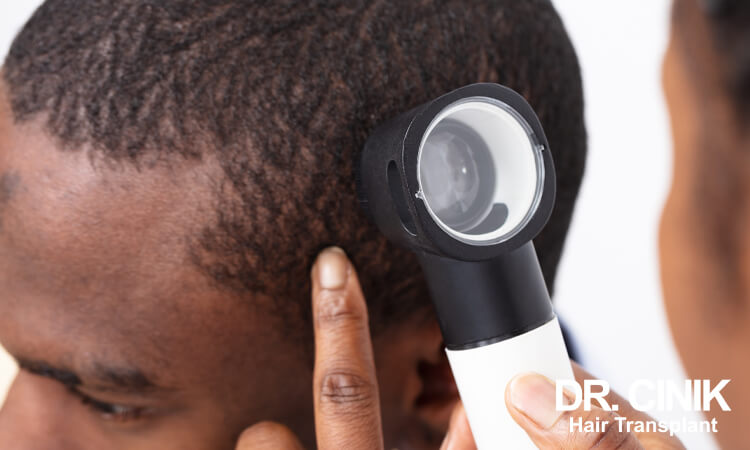
It is believed that hair implantation is the only permanent solution for hair loss and baldness (7). It does not have the side effects of other types of remedies and can promise natural hairstyles.
What Is a Hair Implant?
In a simple view, a hair implant is an act of transferring hair follicles from one part of the body to another, which usually would be the front part of the scalp, beard, and eyebrows.
Hair follicles are harvested from the donor area, which can be the area behind the head and between two ears or chest, and in some cases, the beard. They are extracted in form of grafts and are implanted in the frontal or crown part of the scalp.
Methods of Hair Implant; Which One Is the Best?
Generally, two techniques are used for hair implantation:
- Follicular Unit Transplantation (FUT)
FUT is the older method in this list. A piece of scalp is removed, and the free space created is stitched. Hair from removed skiing is taken and implanted on the frontal part of the scalp. Due to the invasion level in this technique, more side effects are possible and the donor area carries the scars and the stitch line left from the first step of the surgery. - Follicular Unit Extraction (FUE)
FUE is a family of hair implant methods in which hair follicles are extracted one by one from the donor area and implanted in the recipient area individually. FUE family has several variations like Sapphire FUE, DHI, and classification of manual or automated FUE.
Considering the amount of invasion and scar left on the scalp in the FUT technique and the success rate and minimum invasion in the FUE technique, the FUE hair implant technique seems to be the better option for having a hair implant.
The FUE family of hair implants offers a range of options, and the one which fits the best should be selected by considering factors such as grafts needed to cover the balding area.
Who Can Get A Hair Implant?
hair implant is not limited to men suffering from male pattern baldness. Everyone who wants to regain their natural hair after a permanent hair loss or hairline receding can get one. If you are a man or a woman, have straight or afro hair, or are between 25 years old and 65, you can get a hair implant.
However, there remain situations that make it impossible for people to get a hair implant, or at least hinder a successful, natural, and permanent hair implant. It highlights the importance of pre-operation consultations and tests, especially for women whose hair loss shows a strong correlation with hormonal dysfunctions and vitamin deficiencies.
The following criteria are necessary for having a successful hair implant:
- Age: Everyone between the ages of 25 and 65 can have hair implants. (This can change from person to person)
- Donor Area: The donor area should have enough healthy hair. The effectiveness of hair implantation is strongly related to donor hair conditions.
- Illnesses: Some serious medical conditions hinder hair implantation. HIV, blood pressure problems, and autoimmune sicknesses bring about complications.
- Type of hair loss: The best candidate for a hair implant is a person with male pattern baldness.
Make sure before having a hair implant, you will have your blood tested. These blood factors are among the tested factors for men and women:
Blood test items for men before a hair implant |
Blood test items for women before a hair implant |
|
|
What Are hair implant Stages?
hair implant is a multi-step procedure, and these steps are unique to the technique used by your surgeon. Today, FUE and DHI are two of the most common and innovative methods for hair implants.
Follicular Unit Extraction (FUE)
An FUE hair implant consists of the following steps:
- Hairline design and drawing: Your doctor inspects your old photos and determines the hairline for you.
- Shaving the scalp: Your scalp will be shaved.
- Donor area determination: Your donor area will be determined, and a harvesting plan will be designed.
- Local anesthesia: Local anesthetics will be injected into your scalp.
- Donor area harvesting: hair follicles will be harvested as grafts from the donor area. Grafts are clustered into 4 types based on the number of follicles they contain (1,2,3 or 4)
- Channel opening: Using delicate blades (Metal blade or Sapphire blade), channels are opened on the recipient area.
- Channel opening needs a great deal of experience and competency.
- Implantation: Grafts are distributed equally according to their follicle number and implanted in the channels opened.
Direct Hair Implantation (DHI)
A DHI hair implant follows these steps:
- Hairline design and drawing: Your doctor inspects your old photos and determines the hairline for you.
- Shaving the scalp: DHI makes it possible for those who have regional hair loss to keep their long hair and only have the donor and recipient regions shaved.
- Donor area determination: Your donor area will be determined and a harvesting plan will be designed.
- Local anesthesia: Local anesthetics will be injected into your scalp.
- Donor area harvesting: hair follicles will be harvested as grafts from the donor area. Grafts are clustered into 4 types based on the number of follicles they contain (1,2,3, or 4) (8)
- Implantation: Using Choi pens, DHI aggregates channel opening and implantation into a single step. Hair grafts are directly implanted in the recipient area.
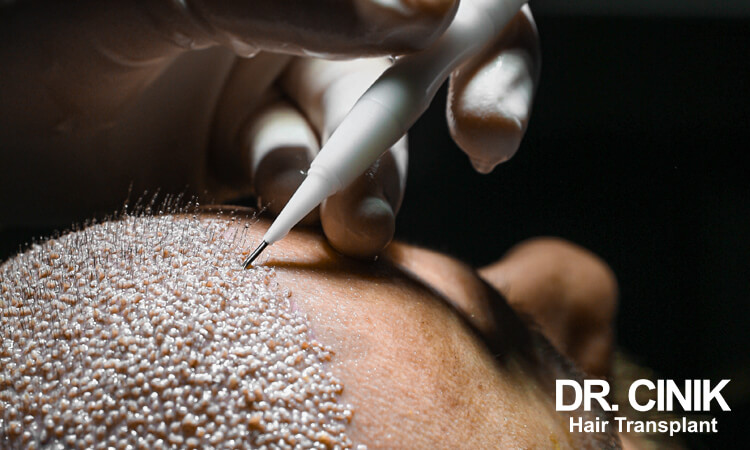
As you can see, DHI and FUE have striking similarities. The only difference would be in the implantation phase. DHI, on the other hand, gives you the option of keeping your long hair and having your hair implanted without full shaving.
What Are Success Factors of a hair implant?
A high-quality hair implant results in a hairstyle that isn’t recognizable from natural hair. If you want to assess the success of a hair implant surgery, consider the following list of signs of a hair implant:
- Natural Hairline: Determining hairline needs a lot of experience. Hairlines that are too low or too high or do not have a natural shape will look ugly and artificial. It also needs a great deal of expertise in the implantation phase as unnatural implantation on the front parts also harms the total hairstyle
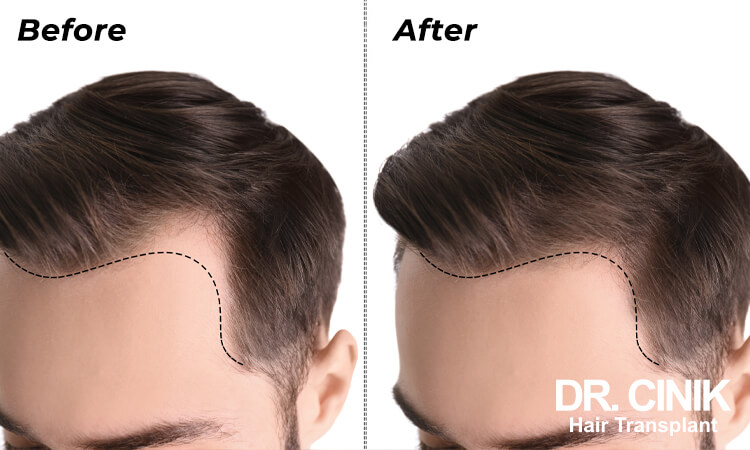
- Optimally Harvested Donor Area: Overharvesting the donor area or harvesting equally from different parts of the donor area can make it look unusual and unnatural. A harmed donor area can also have its natural hair follicles harmed. In a nutshell, you shouldn’t be able to identify a donor part without extensive attention.
- Normal Density: The density of the transplanted hair follicles on the recipient site should be in a normal range. Not only does unnatural density look weird, but also it can cause harm to healthy hair follicles.
- Natural Direction: Doll-shaped hair growth, especially on the frontal part of the hair is a result of an inexperienced surgeon’s channel opening and implantation.
- Equal Distribution of 1,2,3, or 4-Follicle Grafts: Harvested hair follicles can have 1 to 4 hairs. The hair implant team should identify them and collect them into 4 groups, and plan an equal distribution of them. It ensures that the density will be homogeneous.
- Minimum Side Effects and Recovery Time: A high-quality hair implant done by an experienced group of experts (9) doesn’t bring about many side effects and minimizes the recovery period.
What Are the Risks of a Hair Implant?
Like any other medical intervention, a hair implant can have some side effects and complications. Most of these complications (10) are temporary and a part of the healing process. As it is a surgical intervention, some trauma or scabs on the scalp would be inevitable. Some common side effects of a hair implant can be:
- Swelling or bruising
- Scarring
- Bleeding
- Pain or itching
- Infection
- Loss of sensation around the treated areas
- Loss of transplanted hair (shock loss)
- Scalp laxity
- Unnaturally-looking hair
- Hair curl
All of these potential issues are temporary, so there is no need to be concerned if you experience them. Even if you have an infection, your doctor will treat it right away and ensure that your hair normally grows again.
Complications are more likely to arise when the procedure is performed by a doctor who lacks experience. That is why it is critical to select a qualified, experienced surgeon to transplant your hair.
Beard Implant: Get Your Desired Masculine Look!
Beard is the best accessory a man can wear. It is the symbol of masculinity and can easily enhance facial shape and also hide flaws on the face. Additionally, it creates a charismatic look and provides endless styling chances.
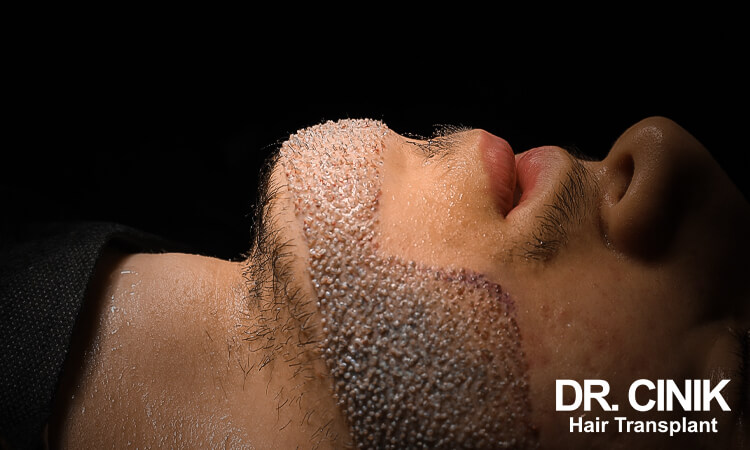
Not Growing Beard: A Bitter Experience,
Unfortunately, a meaningful portion of men suffer from not growing facial hair or not having full beard coverage on their face (for example, having patchy holes). These problems have negative effects on their self-confidence and put a strain on their grooming options.
Do Beard Implants Work?
Beard implants are the only possible way to enjoy having facial hair for people who suffer from not having a full beard. Most of the reasons for not having a full beard are either genetic or permanent (like having patches on the face after experiencing alopecia).
Besides such beard loss reasons, physical damages can cause beard loss, which happens due to damages to the facial hair follicles which are irreversible. Hair follicles do not recover from physical damage and never regrow after dying, so there remains no natural way to regrow facial hair on the physically damaged spot.
Expertise and Experience
To get the best results from a hair implant operation, you have to select a seasoned professional medical center that is accredited by all trustworthy authorities. However, certificates are not enough for a job that has many similarities with art. Experience and a lot of practice are required for all the members of the hair implant center as it is teamwork and has many stages.
Professional hair implant centers have mastered the process, making sure each patient will receive a set of services according to their situation at the best possible quality.
Resources
- Pattern Hair Loss in Men: Diagnosis and Medical Treatment
- Hair Loss: Common Causes and Treatment
- The psychosocial impact of hair loss among men: a multinational European study
- Treatment of Hair Loss
- Platelet-Rich Plasma for Hair Restoration
- Contemporary Hair Transplantation
- Estimating the Number of Lifetime Follicular Units: A Survey and Comments of Experienced Hair Transplant Surgeons
- Forty Steps to Harvest a Graft
- Estimating the Number of Lifetime Follicular Units: A Survey and Comments of Experienced Hair Transplant Surgeons
- The Progressive Loss Risk Scale for Hair Restoration Surgery
 en
en

